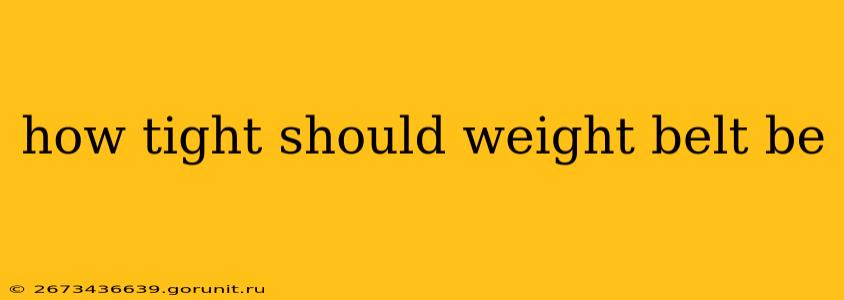Choosing the right weightlifting belt and knowing how tight to wear it is crucial for maximizing its benefits and minimizing the risk of injury. This isn't a one-size-fits-all answer; the ideal tightness depends on several factors, including your individual anatomy, the specific lift, and your personal preference. This guide will help you find that perfect balance between support and comfort.
Understanding the Purpose of a Weightlifting Belt
A weightlifting belt's primary purpose is to provide intra-abdominal pressure (IAP). This increased pressure acts like a natural corset, stabilizing your spine and protecting your lower back during heavy lifting. It doesn't magically add strength; instead, it enhances your body's natural ability to handle heavy loads.
How Tight is Too Tight (and Too Loose)?
The common mistake is thinking the tighter, the better. This is incorrect and potentially dangerous. Here's a breakdown:
Too Loose: A belt that's too loose provides minimal support and won't effectively increase IAP. You'll essentially be wearing it for show, not function.
Too Tight: This is where things can get risky. An excessively tight belt can restrict breathing, causing discomfort and potentially leading to:
- Reduced Blood Flow: Constriction can impede blood flow to vital organs.
- Increased Risk of Hernia: Excessive pressure can strain abdominal muscles, increasing the risk of hernia.
- Discomfort and Pain: An overly tight belt is simply uncomfortable and can cause pain during and after workouts.
Just Right: The ideal tightness allows for a comfortable, deep breath while maintaining a firm feeling around your torso. Think of it as a supportive hug, not a strangling vice.
Finding the Perfect Tightness: A Step-by-Step Guide
-
Proper Placement: Position the belt around your waist, at the natural narrowest point of your torso. This is typically just above your hip bones.
-
Initial Fastening: Secure the belt snugly, but not tightly. You should still be able to comfortably breathe.
-
The Breathing Test: Take a deep breath. If you feel significant restriction, loosen the belt. If you feel minimal to no restriction, proceed.
-
The Lift Test: Perform a few lighter repetitions of the exercise you intend to perform. If you feel insufficient support, tighten the belt slightly. However, always prioritize comfort and breathing.
-
Fine-Tuning: Adjust the tightness as needed during your workout. Your body's needs might vary slightly depending on the exercise and intensity.
When to Use a Weightlifting Belt
While a weightlifting belt can be beneficial for many, it’s not necessary for every lift. Consider using it for:
- Heavy Compound Lifts: Squats, deadlifts, bench presses, and overhead presses (particularly with heavier weights).
- Lifts Requiring Maximal Effort: When pushing your limits on strength-focused exercises.
When NOT to Use a Weightlifting Belt
Using a weightlifting belt for lighter weight or high-repetition exercises is generally unnecessary. Overreliance on a belt can weaken your core muscles over time. Focus on building core strength through dedicated exercises as well.
Conclusion
Finding the correct tightness for your weightlifting belt is a matter of careful adjustment and personal feel. Prioritize comfort and proper breathing while ensuring adequate support. Remember that a weightlifting belt is a tool to enhance your performance and safety; it shouldn't cause discomfort or increase the risk of injury. Always listen to your body and adjust accordingly.

